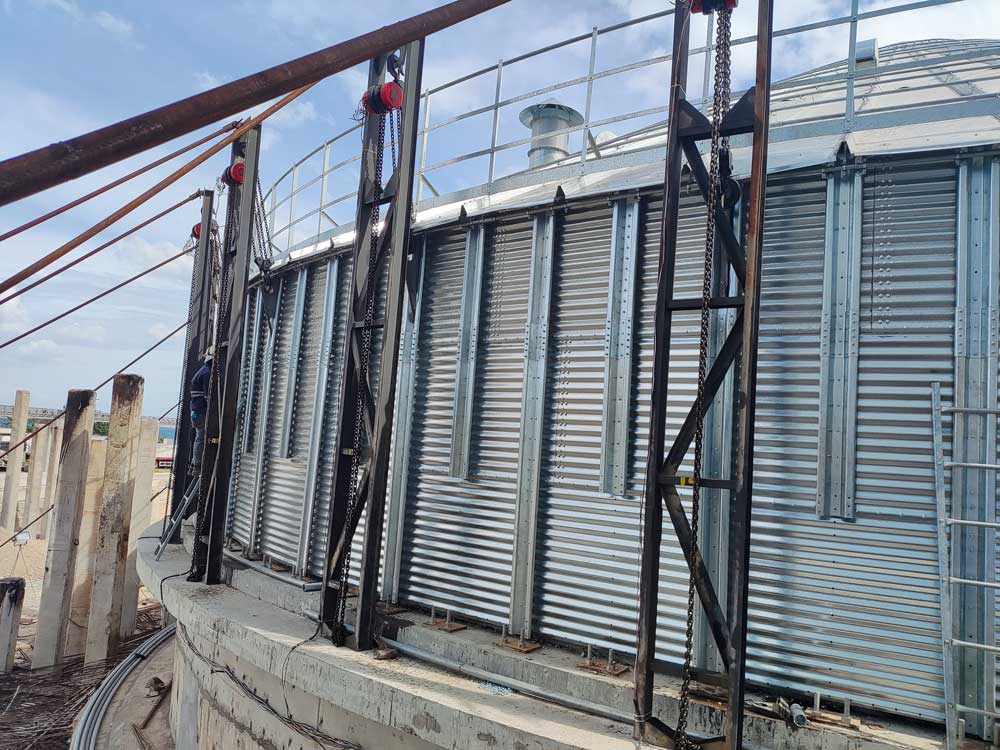In modern grain storage and transportation systems, flat-bottomed and conical-bottomed silos are the two most common steel silo types. Each has its own unique structure, unloading methods, investment costs, and applicable scenarios. They are widely used in grain depots, feed mills, grain trading companies, and terminal storage projects.
Key Structural Features of a Flat-Bottom Grain Silo
A flat-bottom silo has a horizontal floor with a concrete ring beam foundation and a central discharge port. Material is discharged via a screw conveyor or belt conveyor.
To ensure efficient storage, flat-bottom silos are often equipped with a grain sweeper. After gravity discharge, the remaining grain is pushed toward the discharge port. Furthermore, a ventilated floor is installed at the bottom of the silo, coupled with a circulating fumigation system, to provide ventilation, cooling, and insecticide control during storage.
Key Features of a Cone-Bottom Silo Structure
Cone-bottom silos are constructed on an elevated steel platform. Their base is a hopper-shaped cone, typically with an angle between 40° and 60°. Grain discharges by gravity, allowing it to be discharged directly through a discharge valve or chute, requiring minimal human intervention. This structure facilitates rapid silo discharge and is suitable for high-volume applications.
Unloading Efficiency and Operational Differences
Gravity Unloading vs. Grain Sweepers
Conical-bottom silos rely on gravity unloading, resulting in high emptying rates, minimal residual grain, and virtually no manual cleaning, making them suitable for frequent loading and unloading.
Flat-bottom silos, on the other hand, require a grain sweeper for cleaning. While this ultimately allows for complete unloading, the process is more time-consuming and requires more manual involvement, especially in large silos.
Turnover Frequency and Loading and Unloading Rhythm
Trading companies and feed mills typically require frequent inflows and outflows, seeking fast loading and unloading and low residual grain. Conical-bottom silos offer a clear advantage in these situations.
National grain reserves and terminal grain storage, which prioritize long-term, static storage, favor flat-bottom silos due to their larger capacity and more stable construction.
Capacity and Floor Space
Typical Diameter/Height and Single Silo Tonnage
Flat-bottom silos can easily reach diameters exceeding 30 meters and heights of 20–30 meters, with single-silo capacities typically ranging from 5,000 to 20,000 tons. They are ideal for storing bulk grains such as corn and wheat.
Conical-bottom silos typically have a smaller diameter (10–20 meters) and single-silo capacities ranging from 500 to 3,000 tons, facilitating elevated support and rapid material discharge.
Land Space/Civil Engineering Requirements
Flat-bottom silos require a deep foundation and ring beam structure, resulting in a slightly longer construction period but greater overall stability.
Conical-bottom silos utilize an elevated column grid structure, resulting in a relatively shallow foundation, a quick installation period, and a compact footprint. They are particularly suitable for small and medium-sized projects or temporary storage scenarios with limited space.
Ventilation, Temperature Measurement, and Safety
Ventilation System Configuration
Flat-bottom silos often utilize full-floor ventilation with circulation ducts. Fans distribute air evenly through floor openings, making them suitable for long-term grain storage and cooling.
Conical-bottom silos often utilize ventilation ducts or hoppers for air distribution, resulting in a simpler structure but slightly inferior in terms of deep ventilation and temperature control.
Temperature Measurement/CO₂ Monitoring and Automation
Modern grain silos are commonly equipped with temperature sensor cables and CO₂ concentration monitoring devices, which are linked to SCADA systems to implement automatic warnings and intelligent ventilation. Flat-bottom silos, due to their larger storage capacity, require more densely distributed temperature measurement points; conical-bottom silos emphasize real-time monitoring and rapid response.
Moisture-Proofing, Condensation-Proofing, and Airtightness
Moisture-proofing is crucial for long-term grain storage. Flat-bottom silos require strict top ventilation, wall insulation, and a sealed structure to prevent condensation and insects and mildew. Conical-bottom silos, primarily used for short-term or turnover storage, have less stringent airtightness requirements.
Differences in Equipment Procurement and Installation Costs
Flat-bottom silos require a higher initial investment, requiring heavy foundations, grain sweepers, ventilated floors, and other systems.
Conical-bottom silos save on foundations and cleaning equipment, but the cost of the elevated steel structure is not negligible. Overall, a small-capacity conical-bottom silo requires a lower investment, while a flat-bottom silo is more economical for larger capacities.
Energy Consumption and Maintenance
Flat-bottom silos require constant operation of ventilators and sweepers, resulting in slightly higher energy consumption. Conical-bottom silos, on the other hand, rely on gravity unloading, resulting in lower daily energy consumption. Maintenance primarily involves valves and conveying chutes.

Flat-bottomed grain silos and conical-bottomed grain silos each have their own advantages. Flat-bottomed silos prioritize capacity and long-term grain storage safety, making them suitable for large-scale storage depots and strategic warehouses. Conical-bottomed silos excel at unloading efficiency and flexible turnover, making them ideal for feed mills and grain trading companies. When selecting a silo, a comprehensive consideration should be made based on site conditions, construction budget, operational objectives, and grain types. Regardless of the structure, safe, efficient, and cost-effective modern grain storage management can only be achieved through the use of scientific ventilation, temperature measurement, pest control, and automation.




